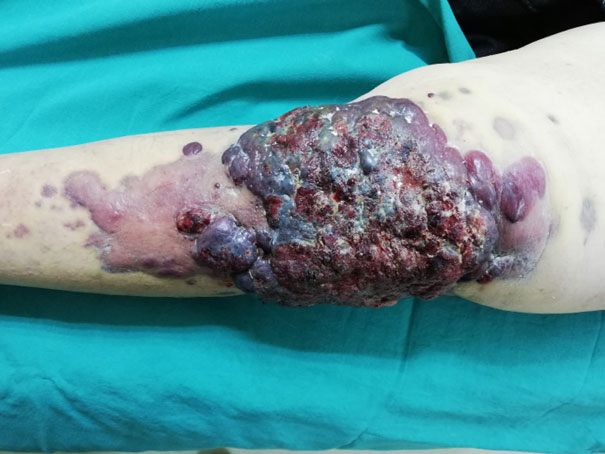ANGIOSARCOMA - HEMANGIOSARCOMA - MALIGNANT HEMANGIOENDOTHELIOMA
- Hits: 692
It is a rare (1-2% of all soft tissue sarcomas) malignant soft tissue tumor that arises from cells in the blood vessel wall (endothelium). It is also known as hemangiosarcoma and malignant hemangioendothelioma. It can occur in blood and lymph vessels.
It is an aggressive, high-grade tumor with a poor prognosis. It can progress rapidly and spread to the tissues in which it is located and through the blood to other organs (bone, other soft tissues), especially the lungs. It is also prone to recurrence after surgery, especially if it is not surgically removed with clean margins.

It usually occurs in middle-aged to elderly patients. It is slightly more common in women (after breast cancer surgery).
It can originate from the surface of the skin in any part of the body, but is particularly prone to occur in the liver and breast tissue. It tends to develop in the liver due to exposure to toxic chemicals (e.g., pesticides containing arsenic) and in the breast due to cancer after removal of the lymph nodes along with the breast tissue. This is called lymphangiosarcoma and is also known as Stewart-Traves syndrome. On the skin, it can occur especially in the area of previous radiotherapy. It can also develop in the soft tissues of the arm or leg.
They begin as painless, small, well-demarcated lesions on the skin, usually purple in color. Over time, they may become larger, more irregular, and more numerous. There may be swelling in the area. There may also be necrosis and bleeding in the center of the mass.
As with other soft tissue sarcomas, diagnosis is always made by biopsy after clinical and radiologic evaluation. It is recommended that the biopsy be performed by an orthopedic oncologist who specializes in bone and soft tissue tumors and that the pathology be evaluated by an experienced pathologist.
The diagnosed patient undergoes PET-CT and brain MRI for screening/grading purposes.
Early diagnosis is the most valuable in terms of patient prognosis. For patients diagnosed before the tumor has spread, the first treatment option is to remove the tumor cleanly with wide margins. Tumors that are not cleanly removed with wide margins have a nearly one hundred percent recurrence rate and are prone to metastasis. For this reason, it is important that the surgeon performing the surgery is an orthopedic oncologist with experience in this area.
Radiotherapy may be given to the surgical site after surgery to reduce the chance of recurrence. Chemotherapy is not very effective, but is used in patients who have metastatic disease. In addition to chemotherapy, targeted drugs can also be used. Radiotherapy and chemotherapy may be used together in patients who are not candidates for surgery.
The location and number of tumors, the age of the patient, the presence or absence of metastases, and the background on which the tumor develops are important in the prognosis of the disease. The prognosis is poor in advanced age, extracutaneous location, presence of metastasis and when it develops on the background of radiotherapy.
Patients treated surgically should be followed closely for recurrence and metastasis.

